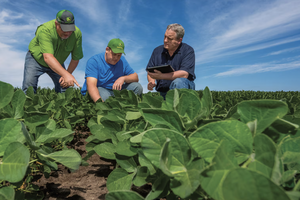Soybean aphids remain one of the most destructive insect pests threatening Iowa's soybean crops. Although populations have been relatively low in recent years, this summer has brought a dramatic surge, with some regions reporting infestations of hundreds of aphids per plant. This leads to honeydew buildup and the development of sooty mold on leaves.
Compounding the issue are growing reports of reduced efficacy with pyrethroid insecticides, raising serious concerns about when to apply treatments and which insecticides are best suited for controlling these pests. Fortunately, guidance from ISU Extension and Outreach offers valuable insights into managing these challenging infestations.
Effective Scouting and Proper Timing for Treatment
Soybean aphid populations can change rapidly throughout the growing season, so it's important to scout regularly. Ideally, scouting should start in June, but farmers who are just beginning now can still manage effectively by using the Speed Scouting method. This approach helps determine whether treatment is necessary by counting up to 40 aphids per plant and using a decision tree. Another proven scouting method is to use the economic threshold of 250 aphids per plant when at least 80% of the plants are infested, and populations are on the rise.
If treatment is required, it's important to consider the growth stage of the plant before spraying. Research consistently shows no yield benefit from applying insecticides after the R6 growth stage (seed set), making timely interventions critical for maximizing crop returns.
Managing Resistance and Choosing Insecticide Options
Foliar insecticides, particularly pyrethroids and organophosphates, have been the go-to solutions for managing soybean aphids. However, resistance to pyrethroids has become a growing concern, particularly in northern Iowa, where studies have detected mutations in aphid populations that reduce the effectiveness of these treatments.
Given this resistance, farmers should approach aphid management with careful consideration of their insecticide choices.
When it comes to managing soybean aphid infestations, ISU Extension and Outreach offers the following key recommendations:
- Scout using Speed Scouting to determine if insecticide treatment is necessary and economical.
- Avoid spraying insecticides after the R6 growth stage, as it's unlikely to increase yield at this point.
- Use high-volume and high-pressure sprays to ensure that the insecticide reaches aphids hiding on the undersides of leaves.
- Be aware of pyrethroid resistance, and don't assume that a pyrethroid application will be fully effective.
- After applying an insecticide, revisit the field within 3-5 days to assess how well the treatment worked. Leaving a check strip untreated can help compare aphid populations in treated versus untreated areas.
- If multiple insecticide applications are required in a single season, rotate the mode of action to reduce the risk of resistance developing.
- Always adhere to the pre-harvest intervals (PHI) for insecticides applied late in the growing season to ensure crop safety at harvest.
Protecting Your Soybean Yields From Aphid Infestations
Implementing ISU's recommended scouting techniques and treatment strategies can enhance your ability to manage soybean aphid infestations and reduce the risk of insecticide resistance. By making timely, informed decisions, you can better protect your crops, optimize yields, and ensure sustainable pest management practices for future growing seasons.
If you're looking for the right agricultural equipment to help navigate these challenges, a local John Deere dealer can help.
